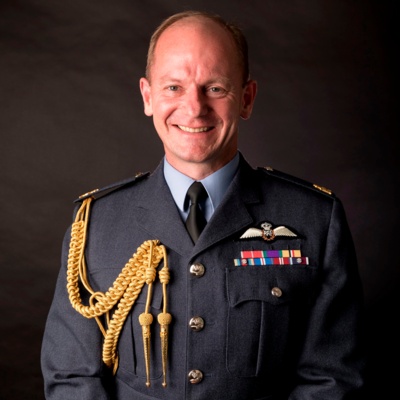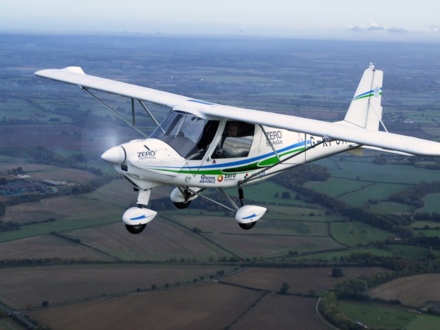
Below is the transcript of the Chief of the Air Staff's speech to a Netzero event - Freeman Air and Space Institute.
Good evening and welcome to this RAF NetZero 2040 event. Thank you to Freeman Air and Space Institute for facilitating and I hope that, by the end of this evening's discussion, you will understand why, and how, I am pushing for the Royal Air Force to be NetZero by 2040.
Some of you will have heard me speak at July’s Global Air Chief’s Conference. Some of you will also have heard me acknowledge that I could be seen as crazy, as an air and space chief, to be talking about sustainability. Five years ago, I would probably have agreed.
But now, the imperative for change could not be clearer: our politicians demand it of us, our public demands it of us and the young people in the Royal Air Force today – the Next Generation Royal Air Force – demand it of the leadership team and me.
In the words of this year’s Integrated Review, climate change is a transnational challenge that threatens global resilience and our shared security and prosperity. Significant action to decarbonise the global economy is required urgently to prevent climate change from accelerating rapidly and possibly irreversibly. We know that collectively our armed forces are responsible for a high level of our respective Governments’ emissions and, within that, our Air and Space activity represents a significant proportion, aviation fuel burn especially.
In the UK, current government legislation requires all greenhouse gas emissions to be net-zero by 2050, but I have set the RAF the ambitious challenge of being climate change resilient and net-zero by 2040, because everything I see and hear tells me that we need to get ahead on this now.
The way we power our aircraft, the way we power our bases, and the way we hold to account our supply chain and our industrial suppliers about their own carbon and sustainable practices, are things that we are going to have to tackle.
We also need to understand how our people, equipment, critical resources and supply chains will need to adapt to operate in a climate-changed future environment. We are aiming for our first NetZero airbase by 2025, a NetZero estate by 2030, and a Carbon Net Balanced Service by 2040.
None of this will be easy. There are complex and wicked challenges ahead of us as an organisation and I am conscious this is not something the Royal Air Force can achieve in isolation. It will take decades, it will require collaboration, it needs ambition, and we need to start now.
Our NetZero2040 strategy comprises three principal strands: NetZero Aviation; NetZero Estate; and NetZero Business as Usual.
I’ll start with NetZeroAviation because aircraft fuel burn is by far and away the greatest challenge that air forces will face to get to NetZero. The same is true for airlines and the commercial aviation sector. We estimate it accounts for up to three quarters of the RAF’s carbon footprint, which in turn is just under half of the Ministry of Defence’s carbon footprint, which in turn is just under half of the whole Government’s footprint. My jet fuel challenge, is Defence’s challenge, and it’s the Government’s challenge.
A lot of what we will do will be on the back of what the commercial aviation sector is doing, and the UK has taken a world leading position in that regard. I sit on the JetZero Council which brings together leaders from across UK aerospace and aviation under the Secretary of State for Transport and the Secretary of State for Business, Energy and Industrial Strategy.
We will continue to push for increased effort commercialising sustainable aviation fuelproduction – that is fuel made from feedstocks such as ethanol or recycled waste oil – and making sure it’s cost-effective, affordable and readily available. Our RAF platforms are already able to operate on a 50% blend of Sustainable Aviation Fuel, or SAF, today, and for some platforms we are pushing with industry for 100% SAF flight as early as next year.
Some of you will have seen that we flew Their Royal Highnesses the Prince of Wales and Duchess of Cornwall to Jordan on the first leg of their current Royal Tour in our Vespina, VIP aircraft with a Sustainable Aviation Fuel blend. So this is already happening.
If there was an assured, affordable supply now, we would use it but, the challenge in the short to medium term is insufficient capacity in the production and supply chains. To put that into context, Global Jet Fuel consumption is around 320m metric tonnes in any normal year. The entire global production of SAF is currently 100,000 metric tonnes, with little immediate prospect of ability to scale it upwards; and its spot price remains steadfastly around ten times that of conventional kerosene.
Some commentators have already started to express a view that Sustainable Aviation Fuel, in its current guise, is not economically viable; but we must at least try to understand the challenges and the opportunities.
And there is an exciting alternative in synthetic – rather than sustainable – aviation fuel. The RAF Rapid Capabilities Office is leading our synthetic fuel production projects, including ground-breaking advances in electrofuels. Electrofuels are not new. The process was first trialled in the early 20th Century but the technology available at that time meant that it was never in competition with refined natural crude. Today, that no longer holds true, new technology and different techniques have shifted that balance and synthetic fuels offer increasing promise.
The new approaches to Synthetic Fuel production are environmentally friendly and sustainable; they offer sovereign security of supply; and the chemically purer fuel we are producing indicates that we will have cleaner engines that result in lower maintenance, longer equipment life, and lower noise, heat and visual signatures such as contrails.
The RAF Rapid Capabilities Office has two separate synthetic fuel projects, both of which are making exciting progress. Last week, you may have seen that the RAF and our industry partner Zero Petroleum won a Guinness World Record for one of those projects, for the world’s first successful flight using only synthetic fuel.
Zero Petroleum’s synthetic petrol is manufactured by extracting hydrogen from water and carbon from atmospheric carbon dioxide. Using energy generated from renewable sources like wind or solar, the hydrogen and carbon are combined under heat and pressure with metal catalysts to create the synthetic fuel. Yes, we are making fuel from air and water. It is alchemy, and the Royal Air Force and Zero Petroleum have proved it can be done.
This world-record achievement was the result of collaboration with brilliant scientists, engineers, designers, and small and medium enterprises across the length and breadth of the UK. As well as a glimpse of the future for fuels, it points to how we will crack the NetZero challenge as a national and international endeavour, and the leading role that UK science and technology can play in that.
I have spoken about sustainable and synthetic fuels, but there are other alternatives to petrol and jet engines, such as electric or hydrogen propulsion, particularly for our smaller lighter aircraft such as training aircraft. We aim to have our first zero emission aircraft operational by the end of this decade. I think it is entirely appropriate that this aircraft will be for our air cadets, university cadets and the very first stages of flying training. If we achieve that, it will be the first military registered and certified zero-carbon aircraft in the world.
The second strand of our strategy is NetZero Bases. Our pilot project is RAF Leeming in Yorkshire and we’re aiming for it to be our first NetZero airbase by 2025. It will require alternate power sources such as solar, geothermal, and hydrogen, and we will make the most of the large land area our bases cover. We are looking at how our runway maintenance programme could be modified to include ground source heat pump technology; or how we install photo-voltaic cells on our hangar roofs.
We are using RAF Leeming to understand how we do this. We’ll prove the technology and test the results there, then roll it out across the remainder of the Royal Air Force estate by the end of the decade. With our bases currently responsible for around 25% of RAF emissions, achieving a NetZero estate by 2030, and then beyond that moving to net negative and offsetting our aviation emissions, is a critical element of the RAF strategy and achieving that Netzero 2040 ambition. From an operational perspective, that independence from the national grid and from energy supply makes us much more resilient too, better postured to defend our skies and space into the future.
I also recognise the obligation on the RAF to support other national initiatives to hit the UK’s ambitious climate change goals. The UK’s offshore wind industry is set to generate 40GW of power by 2030. The relationship with MoD hasn’t always been easy; these offshore windfarms act as complex spinning radar reflectors, confusing our ability to maintain the clear radar picture we need to keep our skies safe. Historically MOD has objected to such developments, but in recent years, the MOD, led by Air Vice-Marshal Linc Taylor, sits on a joint board with our Offshore Wind Industry Council – with each partner determined to find a way that Air Defence radars can operate effectively alongside even the biggest windfarms.
Our NetZero ambition is a great ambition, but there will be risks and trip-hazards along the way. We are a fighting force that must continue to protect our nation, something we cannot compromise on our journey to NetZero. I know there will be difficult prioritisation decisions in the years and decades ahead, but if we are thinking about them now, we will be better able to navigate our way through at pace.
It is not a zero-sum game though. I can already point to significant benefits of a more sustainable force structure, whether operating from home base, or deployed. Renewable power generation like solar or small hydrogen power units removes the requirement for a massive fuel and logistics supply tail, and the vulnerability and headaches that attracts. And taking it one step further, just imagine if the synthetic fuel plant I described earlier, could be deployable too, and we were able to make our own jet fuel at a deployed operating base or at sea as part of HMS Queen Elizabeth’s carrier strike group.
I am conscious our net zero ambitions are not something the Royal Air Force – or any organisation – can achieve in isolation and we are already working with the rest of Government, industry, scientists, academia, think tanks, and other air and space forces around the globe, drawing on the power of our collective resources to address this pressing challenge.
Earlier this year we launched the Global Air Chiefs Climate Change Initiative inviting my international counterparts to explore the opportunities to collaborate on a global basis, sharing ideas and intent. Air forces from over 41 countries are already participating with eight workstrands underway.
I am confident our NetZero ambition and the strategy to take us there will reduce our impact on the environment. It has the potential to make us more resilient too, both in terms of supply-chain dependencies, and in terms of how our people, equipment, and infrastructure adapt to a climate-changed future environment. It will not be easy. We will have to make some extraordinary leaps in fuel, aircraft and propulsion technology, we will have to transform our air bases and the buildings on them; it will require collaboration with many different partners; and I know it will require significant investment and commitment to achieve. It will take decades, and I tell my next generation of leaders that it will largely fall to them to deliver, so they must get their heads around it now.
I am proud of the leading role the Royal Air Force has already taken in this, nationally and internationally, and I am no doubt we will continue to lead the way, as we have done throughout our history. We are but a small part of a much bigger societal and global effort, but it is critical to all our futures, and I am excited the Royal Air Force is a part of it.
Thank you for listening this evening. Questions?






